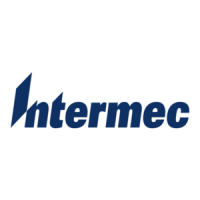Co de 39
Nugget
Configuration Command Reference
9-21
9
Code 39
Purpose: Enables or disables decoding of Code 39 symbology. Code 39 is discrete, variable length,
and self-checking. The character set is uppercase A to Z, 0 to 9, dollar sign ($),
period (.), slash (/), percent (%), space ( ), plus (+), and minus (-).
There are three types of ASCII the terminal decodes:
• Code 39 non-full ASCII
• Code 39 full ASCII
• Code 39 mixed-full ASCII
Code 39 non-full ASCII Non-full ASCII uses a one-character encoding scheme. For
example, you encode the data “SAMPLE” as follows:
*SAMPLE*
*SAMPLE*
This label decodes as
SAMPLE
.
Code 39 full ASCII Full ASCII uses a two-character encoding scheme to extend the
character set to 128 characters. You use the dollar sign ($), slash (/), percent (%), or plus
(+) followed by an uppercase letter to represent one of the characters in the extended set.
You must encode lowercase letters as a plus sign (+) followed by their uppercase
equivalents. For a list of ASCII characters and their Code 39 representations, see the
“Full ASCII Table” in Appendix B.
Use Code 39 full ASCII to enter ASCII control characters or lowercase characters as
data. You should also enable Code 39 full ASCII to use ASCII command characters.
For example, you encode the data “sample” in Code 39 full ASCII as follows:
*+S+A+M+P+L+E*
*+S+A+M+P+L+E*
In Code 39 non-full ASCII, this label decodes as
+S+A+M+P+L+E
. In Code 39 full
ASCII, this label decodes as
sample
.
Code 39 mixed-full ASCII Use mixed-full ASCII when printers encode the same label
two different ways. For example, if you have a bar code with the data $%a, some printers
encode the data as follows:
*/D/E+A*
*/D/E+A*
In the Full ASCII Table in Appendix B, /D represents $ and /E represents %. If you
configure the terminal for Code 39 full ASCII, the terminal decodes the data as $%a
because there are three valid full ASCII character pairs to represent the data.

